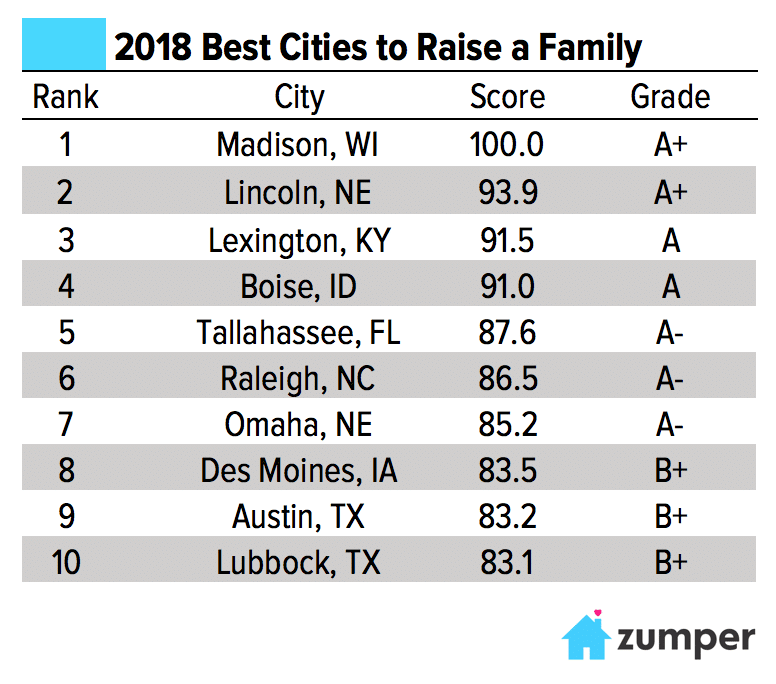As some of you may start to think about having kids and life in a big city could begin to grow old, you may be thinking about packing up and heading somewhere else to start the next chapter in your life, but where should you go? Northeast? Midwest? Luckily for you, we looked at ten key factors in the largest cities across the United States to compile our first-ever ranking of the Best Cities to Raise a Family.
Key Findings
– Madison Comes Out on Top: Madison, WI tops our first ever rankings of the Best Cities to Raise a Family. Thanks to a large population of younger adults, a strong local economy, and low crime high school dropout rates, Madison scored well above the other cities in our rankings.
– The Midwest and South Dominate: Of the ten best cities to raise a family, nine of them were either in the Midwest or the South, which was due largely to lower mortgage expenses for homeowners, shorter commutes, strong local economic conditions, and lower infant care costs.
– Northeast Shutout: There were no cities in the Northeast near the top of our rankings with Syracuse, NY coming in with the highest ranking of cities in the region at 25. While many of these cities have large populations of younger people, they were dragged down by higher spending on mortgages, longer commutes, and higher infant care costs.
Best Cities to Raise a Family
1. Madison, WI – The state capital and home to the University of Wisconsin, Madison has a lot to offer families. It had the lowest high school dropout rate of any city in our rankings, which should excite any would-be parent. Beyond that, residents in Madison can boast about their low commute times, averaging nineteen minutes, the fact that 69% of the population is under 45, and a current unemployment rate of 2.1%.
2. Lincoln, NE – Another midwestern state capital and home to a major public university comes in at number two in our rankings. Lincoln scored well thanks to short commute times, a low high school dropout rate, low infant care costs, and the lowest reported mortgage costs as a percentage of income, with only 20.3% of residents reporting to have spent more than 30% of their income on housing costs.
3. Lexington, KY – Lexington took third place overall on our list, ranking highest among cities in the South. Lexington scored well on a number of the economic indicators, like child care and housing costs, while it also had low highschool dropout and violent crime rates.
4. Boise, ID – Boise emerged as the only city in the West to crack the top ten, as other cities in the region were often plagued by high cost of living. Boise scored well thanks to short commute times, low infant care and housing costs, as well as a mere sixty dollar difference between the average price of a one and two bedrooms in our rental data.
5. Tallahassee, FL – Beating out Orlando and Tampa, Tallahassee came in it at number five in our rankings and as the highest in the state of Florida by a fairly large margin. State capitals continue to dominate the top of our rankings, and this city has plenty of museums and a rich history with much to offer families with young children. Tallahassee benefitted from its low average commute times, low costs for renters, and 73.3% of residents under the age of 45, the highest of any city that we analyzed.
6. Raleigh, NC – Raleigh came in at number six in our rankings, benefitting from strong economic conditions, a high prevalence of younger people, and low high school dropout and violent crime rates. Families considering a move to the area would also benefit from the strength of the Raleigh metro area as a whole, as neighboring cities Chapel Hill and Durham are both home to large universities and could be attractive places to start a family.
7. Omaha, NE – The second state in Nebraska to crack the top ten of our rankings, Omaha scored well thanks to its low housing and infant care costs as well as low average commute times for its residents.
8. Des Moines, IA – Des Moines placed eighth in our rankings. It, like many of the other cities in the Midwest, scored well due to lower than average housing costs, including an only $40 difference between a one and a two bedroom rents, as well as low reported commute times and a very low unemployment rate of only 2.1%.
9. Austin, TX – Narrowly beating out Lubbock for the highest ranking in the state of Texas, Austin scored well thanks to strong economic indicators, like its low unemployment rate and high median family incomes, as well as a large population of people under the age of 45. Austin, however, scored poorly in other categories, particularly due to higher housing costs for renters as well as longer than average commute times.
10. Lubbock, TX – Lubbock rounds out the top of our first ever ranking of best cities to raise a family. Lubbock was bolstered by lower average housing costs for individuals with a mortgage, a large population of people under 45, and the shortest commute time of any city in our rankings, as residents report an average daily commute of a mere sixteen minutes.
Methodology
In order to create these rankings, we began with the one hundred cities from our monthly rent reports. From there, we pared the list down to ninety-five cities, as we had to remove the few cities that either had incomplete data or overlapped with one another in the census data. We then ranked cities on the following ten factors, all of which were equally weighted, and then normalized the final scores:
1. Cost Per Additional Room – Calculated as the difference between a one-bedroom and a two-bedroom using our monthly Rent Report data.
2. Percentage of Income Spent on Rent – Collected from the 2016 5-Year American Community Survey (Median Gross Rent as a Percentage of Household Income in the Past 12 Months)
3. Percentage of Income Spent on Mortgage – Collected from the 2016 5-Year American Community Survey (Selected Monthly Owner Costs as a Percentage of Household Income in the Past 12 Months for Housing Units with a Mortgage)
4. Median Household Income – Collected from the 2016 5-Year American Community Survey (Median Household Income)
5. Current Unemployment – Collected from the Bureau of Labor and Statistics (Unemployment Rates for Metropolitan Areas, May 2018)
6. Infant Care Costs – Collected from Child Care Aware
7. Percentage of Population Under 45 – Collected from the 2016 5-Year American Community Survey (Age)
8. Highschool Dropout Rate – Collected from the 2016 5-Year American Community Survey (School Dropout Rate for Population 16 to 19 Years)
9. Average Commute Time – Collected from the 2016 5-Year American Community Survey (Average Commute to Work)
10. Violent Crime Rate – Collected from the FBI Uniform Crime Reporting database
Full Rankings:
| 1 Bedroom | 2 Bedrooms | ||||||
|---|---|---|---|---|---|---|---|
| Pos. | City | Price | M/M % | Y/Y % | Price | M/M % | Y/Y % |
| 1 | South Jordan | $1,100 | 4.80% | 8.90% | $1,350 | 0.00% | 0.70% |
| 2 | Sandy | $1,090 | -0.90% | 14.70% | $1,340 | 0.00% | 15.50% |
| 3 | Salt Lake City | $1,040 | 0.00% | 15.60% | $1,350 | -2.20% | 14.40% |
| 4 | Cottonwood Heights | $1,030 | 0.00% | 8.40% | $1,210 | -0.80% | 11.00% |
| 5 | Draper | $1,010 | -1.90% | 1.00% | $1,380 | 3.00% | 7.80% |
| 6 | Midvale | $980 | 3.20% | -6.70% | $1,110 | 0.00% | 4.70% |
| 7 | West Jordan | $950 | -1.00% | 8.00% | $1,090 | 2.80% | 14.70% |
| 8 | Murray | $940 | 0.00% | 13.30% | $1,030 | -1.00% | 14.40% |
| 9 | Taylorsville | $890 | -1.10% | 6.00% | $1,030 | 1.00% | 7.30% |
| 10 | Millcreek | $880 | 4.80% | 10.00% | $1,060 | 1.90% | 11.60% |
| 11 | West Valley City | $830 | -2.40% | 2.50% | $1,030 | -1.90% | 12.00% |
| 12 | South Salt Lake | $810 | -1.20% | 8.00% | $980 | 4.30% | 15.30% |





